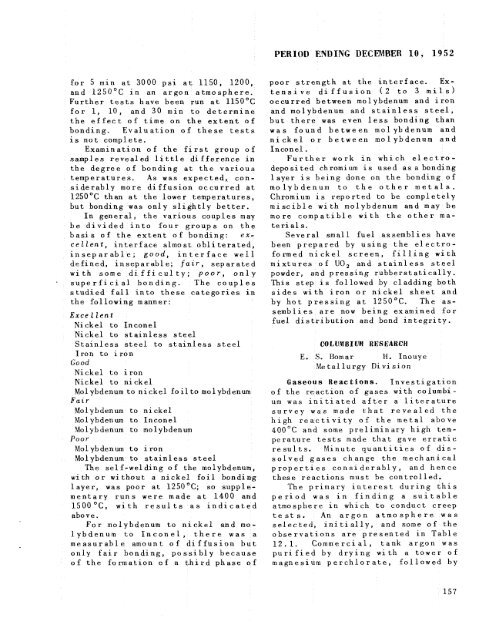the Molten Salt Energy Technologies Web Site
the Molten Salt Energy Technologies Web Site
the Molten Salt Energy Technologies Web Site
Create successful ePaper yourself
Turn your PDF publications into a flip-book with our unique Google optimized e-Paper software.
for 5 min at 3000 psi at 1150, 1200,<br />
and 1250OC in an argon atmosphere.<br />
Fur<strong>the</strong>r tests have been run at 1150°C<br />
for 1, 10, and 30 min to determine<br />
<strong>the</strong> effect of time on <strong>the</strong> extent of<br />
bonding. Evaluation of <strong>the</strong>se tests<br />
is not complete.<br />
Examination of <strong>the</strong> first group of<br />
samples revealed little difference in<br />
<strong>the</strong> degree of bonding at <strong>the</strong> various<br />
temperatures. As was expected, considerably<br />
more diffusion occurred at<br />
1250'C than at <strong>the</strong> lower temperatures,<br />
but bonding was only slightly better.<br />
In general, <strong>the</strong> various couples may<br />
be divided into four groups on <strong>the</strong><br />
basis of <strong>the</strong> extent of bonding: excellent,<br />
interface almost obliterated,<br />
insep ar ab1 e; good, inter face we1 1<br />
de fined, in sep ar ab1 e; fa i r , sep ar a te d<br />
with some di f f i cul ty; poor, only<br />
* superficial bonding. The couples<br />
studied fall into <strong>the</strong>se categories in<br />
<strong>the</strong> following manner:<br />
Exce 1 Zen t<br />
Nickel to Inconel<br />
Nickel to stainless steel<br />
Stainless steel to stainless steel<br />
Iron to iron<br />
Good<br />
Nickel to iron<br />
Nickel to nickel<br />
Molybdenum to nickel foil to molybdenum<br />
Farr<br />
Molybdenum to nickel<br />
Molybdenum to Inconel<br />
Molybdenum to molybdenum<br />
Poor<br />
Molybdenum to iron<br />
Molybdenum to stainless steel<br />
The self-welding of <strong>the</strong> molybdenum,<br />
with or without a nickel foil bonding<br />
layer, was poor at 1ZSO'C; so supplementary<br />
runs were made at 1400 and<br />
1500°C, with results as indicated<br />
above.<br />
For molybdenum to nickel and molybdenum<br />
to Inconel, <strong>the</strong>re was a<br />
measurable amount of diffusion but<br />
only fair bonding, possibly because<br />
of <strong>the</strong> formation of a third phase of<br />
PERIOD ENDING DECEMBER 10, 1952<br />
poor strength at <strong>the</strong> interface. EX-<br />
tensive diffusion (2 to 3 m i l s )<br />
occurred between molybdenum and iron<br />
and molybdenum and stainless steel,<br />
but <strong>the</strong>re was even less bonding than<br />
was found between molybdenum and<br />
nickel or between molybdenum and<br />
Inconel.<br />
Fur<strong>the</strong>r work in which electro-<br />
deposited chromium is used as a bonding<br />
layer is being done on <strong>the</strong> bonding of<br />
molybdenum to <strong>the</strong> o<strong>the</strong>r metals.<br />
Chromium is reported to be completely<br />
miscible with molybdenum and may be<br />
more compatible with <strong>the</strong> o<strong>the</strong>r ma-<br />
terial s.<br />
Several small fuel assemblies have<br />
been prepared by using <strong>the</strong> electro-<br />
formed nickel screen, filling with<br />
mixtures of UO, and stainless steel<br />
powder, and pressing rubberstatically.<br />
This step is followed by cladding both<br />
sides with iron or nickel sheet and<br />
by hot pressing at 1250°C. The as-<br />
semblies are now being examined for<br />
fuel distribution and bond integrity.<br />
COLUMBIUM RESEARCIl<br />
E. S. Romar H. Inouye<br />
Me tal lurgy Division<br />
Gaseou s Reac t ions. I nve s ti ga ti on<br />
of <strong>the</strong> reaction of gases with colurnbi-<br />
um was initiated after a literature<br />
survey was made that revealed <strong>the</strong><br />
high reactivity oi <strong>the</strong> metal above<br />
400°C and some preliminary high tem-<br />
perature tests made that gave erratic<br />
results. Minute quantities of dis-<br />
solved gases change <strong>the</strong> mechanical<br />
properties considerably, and hence<br />
<strong>the</strong>se reactions must be controlled.<br />
The primary interest during this<br />
period was in finding a suitable<br />
atmosphere in which to conduct creep<br />
tests. An argon atmosphere was<br />
selected, initially, and some of <strong>the</strong><br />
observations are presented in Table<br />
12.1. Commercial, tank argon was<br />
purified by drying with a tower of<br />
m agne si um perchlorate , fo 1 lowed by<br />
157



![Review of Molten Salt Reactor Physics Calculations [Disc 2]](https://img.yumpu.com/21979492/1/190x247/review-of-molten-salt-reactor-physics-calculations-disc-2.jpg?quality=85)












